On the Road is a weekday feature spotlighting reader photo submissions.
From the exotic to the familiar, whether you’re traveling or in your own backyard, we would love to see the world through your eyes.
Albatrossity
By the time you are reading this, it will definitely be well into fall, or even winter, weather. We got our first hard freeze here in Flyover Country on 10/17/22, and winter’s monotone colors will be here soon enough. Our winter hawks are trickling in, and I can report that Harley checked in, for his tenth winter here in Kansas, on October 25 this year. But this week’s images still have some fall colors and critters; I hope you enjoy them!
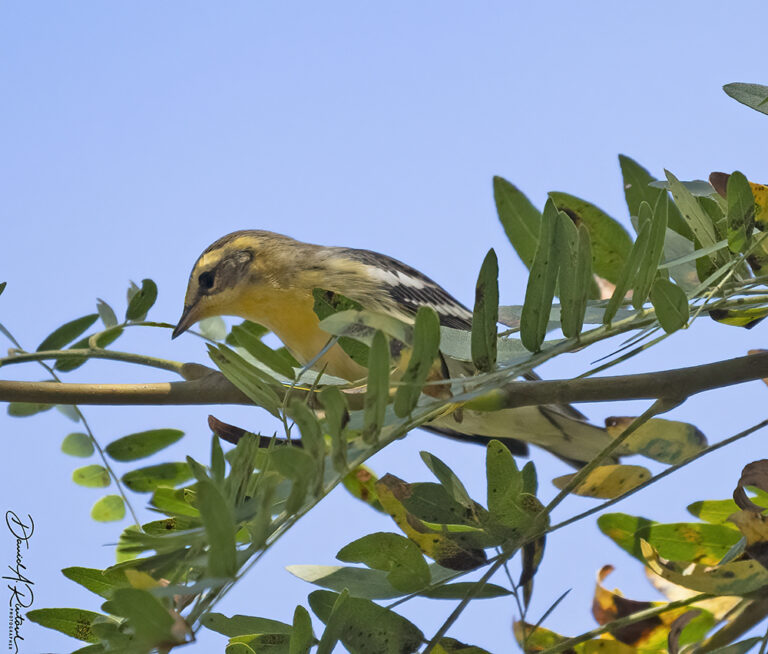
Fall warbler migration in my part of the country is pretty “meh”. Diversity is low (4-5 warbler species in a morning is a dang good morning), and most fall warblers are not super colorful anyway. But I did add one new warbler to the yard list this season. This Blackburnian Warbler (Setophaga fusca) showed up at the bird bath when I happened to be glancing out the window, and spent the next hour or so foraging in our walnut and locust trees. I’ve seen this species exactly once before in the state, so it was a real treat to have one in the backyard! Click for larger image.
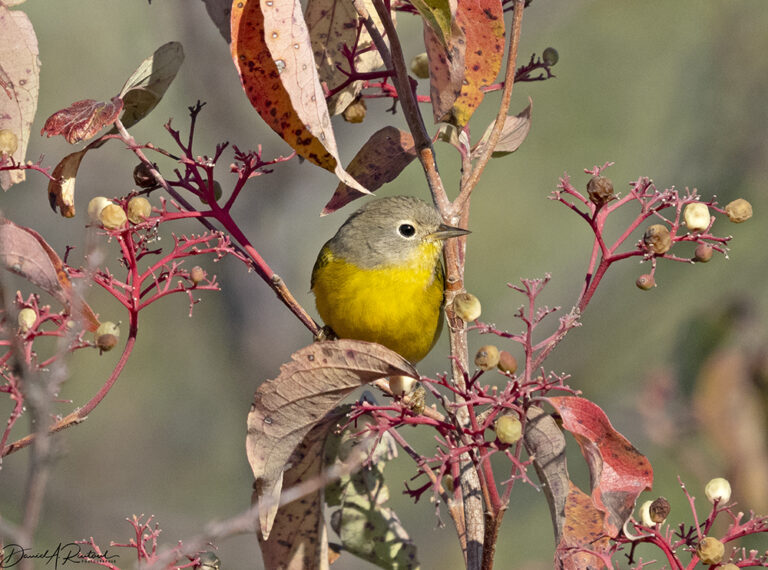
There are about three or four common fall warbler migrants here, and this is one of those. It’s a Nashville Warbler (Oreothlypis ruficapilla, also featured in last Monday’s OTR), in a colorful patch of rough-leaf dogwood. Click for larger image.
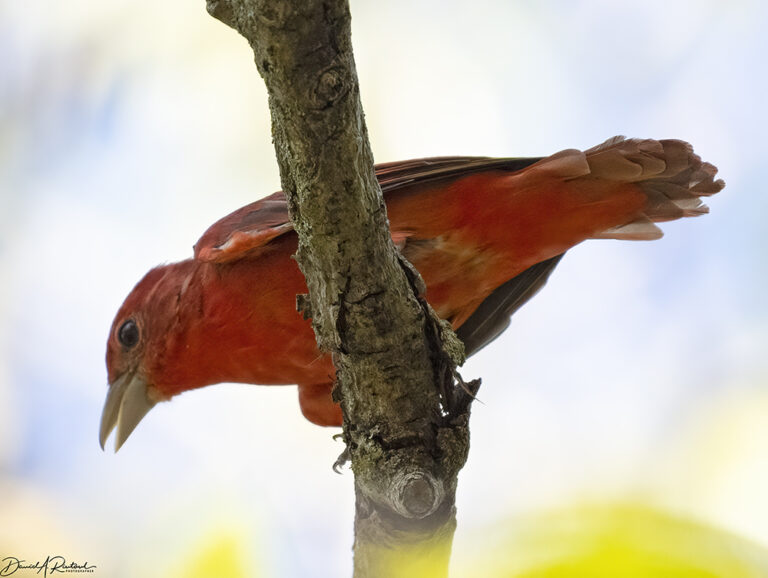
Our Summer Tanagers (Piranga rubra) molt into new feathers before they head to Central America, and you can see that this male still has some tail feathers to grow before he heads south. Click for larger image.
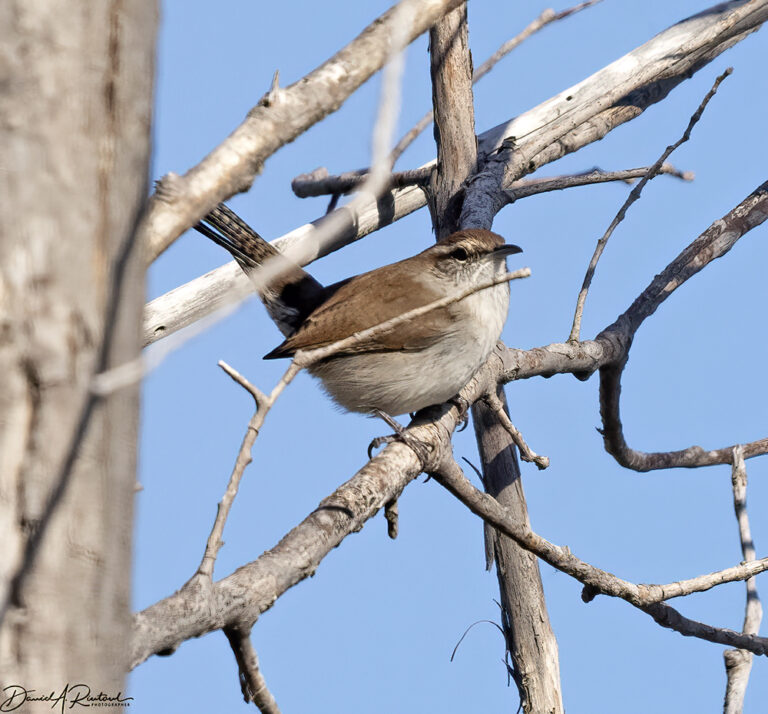
Bewick’s Wrens (Thyromanes bewickii) are summer residents here, and some actually stick around for the winter these days. But they are uncommon and secretive in these parts, unlike their conspecifics further west. It’s a good day when I can get a picture of one of these guys here! Click for larger image.
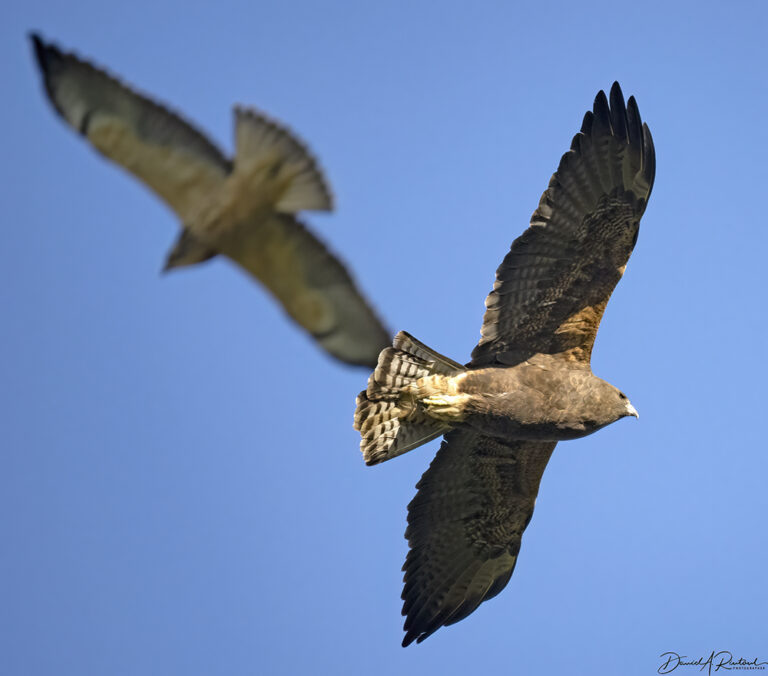
Another species that is an uncommon summer sight here is the Swainson’s Hawk (Buteo swainsoni), although it becomes much more abundant just a bit west and north of us. They migrate south in large flocks, and come in two color morphs, light and dark. The dark ones are not common east of the Rockies, but I was lucky enough to find one and photograph it with a light morph bird soaring above it. By the time you read this, most of these birds will be in Central America, and a few birds will already be in Argentina or Uruguay. Click for larger image.
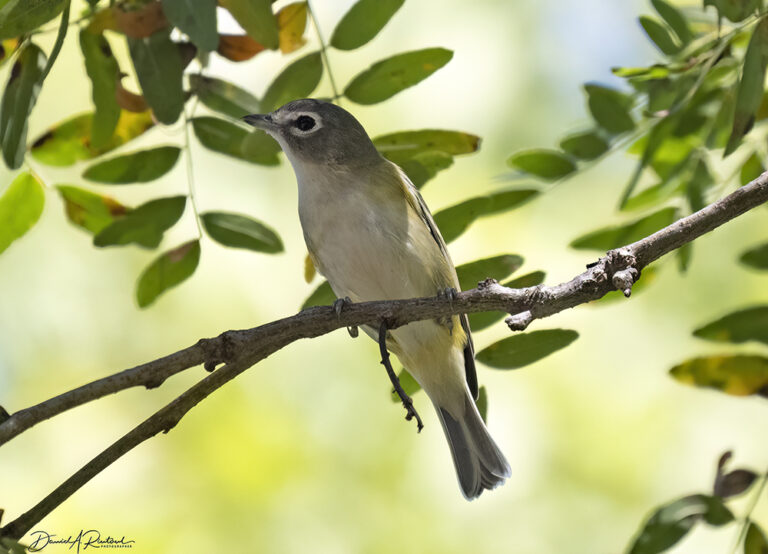
Blue-headed Vireos (Vireo solitarius) breed well to the north of us, but are a pretty common fall migrant here. Formerly known as the Solitary Vireo, the species was split into three (Cassin’s, Plumbeous, and Blue-headed). This is the most common one, with the largest breeding range, so it retained the specific epithet solitarius. And it’s true; I never seen more than one at a time! Click for larger image.
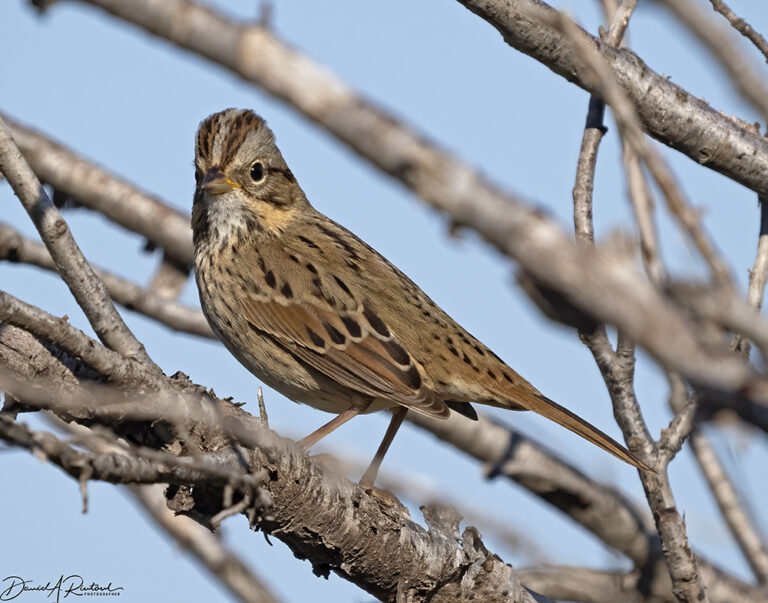
Lincoln’s Sparrows (Melospiza lincolnii) brighten any fall day, with their dapper and perky appearance and muted but elegant coloration. These are a common breeding species in the Rocky Mountains, but our fall birds probably come from the boggy and buggy boreal forests of Canada. Here’s a video of another Lincoln’s Sparrow who was preening and rousing (ruffling the feathers) in a pokeberry patch later this fall. Click for larger image.
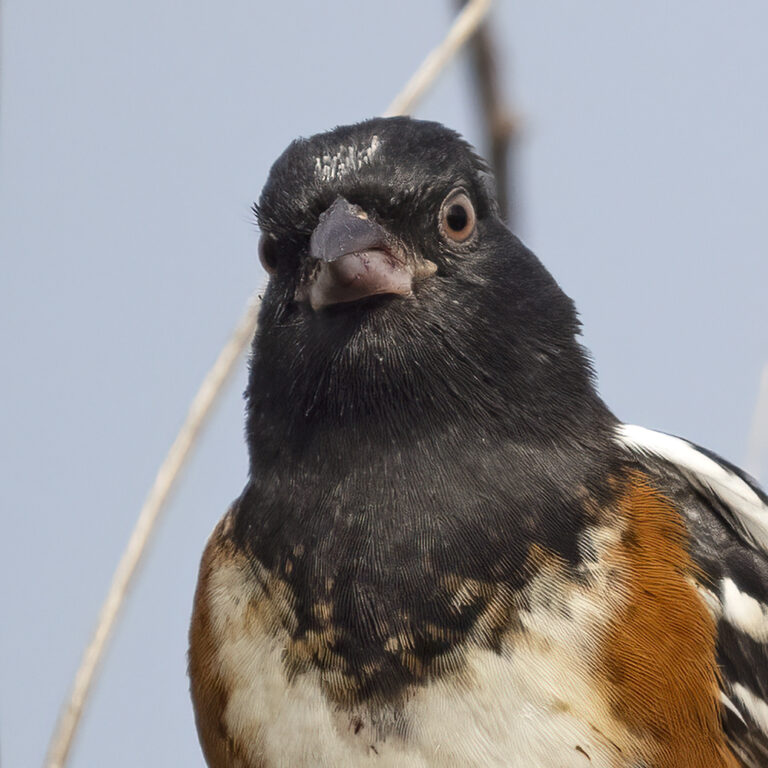
This large sparrow, the Spotted Towhee (Pipilo maculatus) also is a common breeding species west of here as well as north. Our summer resident Eastern Towhees have already skedaddled southeast for the winter; these are their winter replacements here. This one is still molting; that’s not a patch of white paint on his head; those are the sheaths of new feathers growing in to keep his cranium warm in the upcoming winter months. Click for larger image.
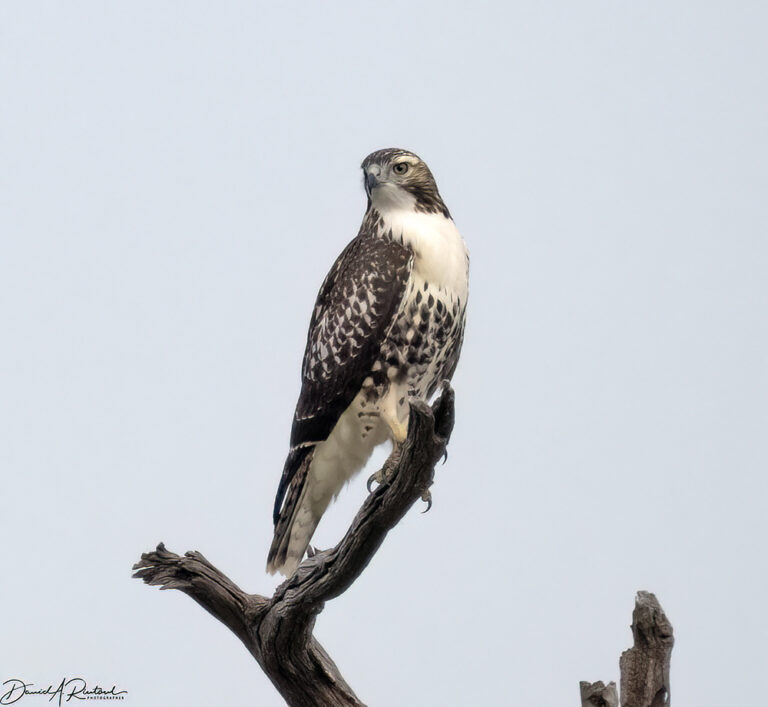
The winter hawk season is the best part of living in Flyover Country, in my opinion, because we can find representatives of 5 very different subspecies of the Red-tailed Hawk (Buteo jamaicensis), as well as many intergrades resulting from mixed-subspecies pairs. The months between October and March are full of interesting hawk sightings. This was the first migrant Red-tailed Hawk I saw this season, a representative of the eastern (borealis) subspecies from further north of here. A handsome specimen indeed! Click for larger image.
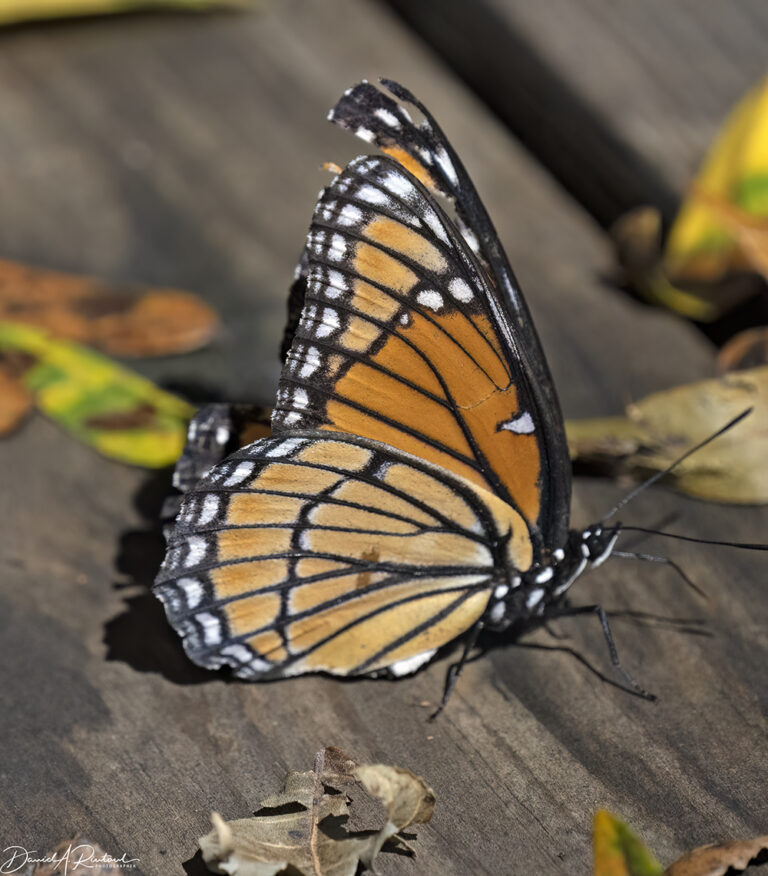
The final image is not a bird at all, but a Viceroy butterfly (Limenitis archippus) which landed on the back deck while I was waiting to photograph the Blackburnian Warbler above. They closely resemble the Monarch Butterfly, and are equally unpalatable to predators, but can be distinguished from that species by the dark line that goes all the way down the middle of the hind wing. Click for larger image.

SiubhanDuinne
Wonderful photos and informative captions as always. (I didn’t know you were a lepidopterist as well as an ornithologist!)
Reboot
The Spotted Towhee looks highly skeptical.
SteveinPHX
Great photos as always. Great pose from the red-tail! Thank you!
Pete Mack
Russia is obviously grossly undercounting cases. 1400 hospitalized means on the order of 100000 new cases (with 1-2 week delay.)
Betty
The creamy breast of the Red-tailed Hawk is gorgeous.
Betsy
Great birds! You are really good at finding them.
WaterGirl
Happy Monday, Albatrossity! Hope you enjoyed the ability to sleep in yesterday. :-)
Yutsano
Dat Lincoln’s sparrow has some attitude to him. “U talkin’ 2 me?” I just love your bird pics both here and on Twitter.
Albatrossity
@WaterGirl: Thanks! I did sleep in (until 6:30 or so) yesterday!
Albatrossity
@Yutsano: Thanks. Right now I am abstaining from Twitter, waiting to see if Musk can behave himself, or if he shows his typical maturity level (13 year-old boy). I’m not optimistic…
RaflW
We had a lengthy visit by Meleagris gallopavo (aka a wild turkey) on our townhouse deck the other day. They had to jump/flap over a 30″ or so wrought iron fence to get in. It looked like maybe there were some tasty insects among the fallen leaves on the deck, and the railing and trellis maybe let the bird feel safer from (rare, I think) predators. We haven’t seen the red fox from fall a year ago that was making itself comfy in our community courtyard.
We did chase the turkey out when it started pecking the windowframe. After being gone a bit, it flew back in, and we just let it be. All this just one mile from the highrises of downtown Minneapolis!
eta: All the photos are great, but that Swainson’s Hawk image… Wow.
Albatrossity
@RaflW: Yes, in the wintertime we have a flock of turkeys in the neighborhood that ranges in number from 50-80, depending on the year. We have a heated birdbath on the deck, which is about 20 ft above the ground, and the turkeys regularly flap up there and partake of the liquid refreshments. In the spring, the toms strut and preen in the yard, trying to impress the ladies, and occasionally they get confused by their reflection in the downstairs windows.
They are impressive beasts,
A woman from anywhere (formerly Mohagan)
@Albatrossity: We had a bachelor flock of five young turkey toms hanging around our property this summer and fall. We originally thought they were hens, but lately, they developed their breast beards, started squabbling among themselves, and dispersed. Ah well, everyone has to grow up, I guess.
StringOnAStick
Your bird photos are always a treat!
I love seeing birds and designed the landscape to encourage them, and we keep two seed feeders and two finch feeders going year round. I’m not as thrilled with the flicker that decided the tear the plastic mesh out that covered the back of our soffit vent holes, that are quite stupidly designed to look exactly like a row of three, perfect flicker sized round holes. Some 1/4″ hardware cloth and U staples later, and they’ve had to search out a new abode. I’ve covered 5 sets of those vents so far and need to do 8 more, bit it is snowing hard so I’ll wait a day or two.